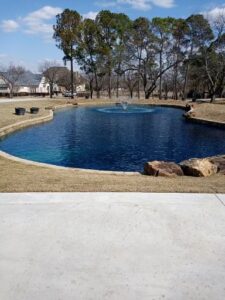Pond dye is very effective at reducing annual pond management costs. These colorants act as a preventative measure and are an integral part of an Integrated Pest Management (IPM) program. When compared to algaecides and herbicides, these dyes are less harsh on the environment and are more cost efficient. Dyes are not pesticides and have no toxic effect on plants or algae. Instead, they are extremely concentrated “food grade” dyes. These dyes are commercially packaged in both liquid formulas and water soluble packets.
Submersed aquatic vegetation and most algae begin their growth on the pond bottom. The depth and clarity of the water are critical factors in limiting where and how fast the growth occurs. Noxious growth always begins in shallow water where sunlight can reach the bottom. Without sunlight, these aquatic pests can’t flourish due to the inability to photosynthesize their own food. A general rule of thumb is that growth will start to be hindered at a water depth of 3 feet. However, very clear water can allow growth in water as deep as 6-8 feet.
Pond dyes act by shading out these shallow water areas and reducing the ability for submersed aquatic growth to get established. They are in essence filtering out the rays of sunlight that are paramount for photosynthesis. This results in less frequent and smaller dose pesticide applications over the year, ultimately leaving more money in your pocket.

After Pond Dye Application
Pond dyes can also be used solely as an aesthetic modification to your pond. Every pond has unique physical and chemical characteristics which determine the natural water color. Therefore, ponds in North Texas can range anywhere from crystal clear, coffee or tea colored, green, and all points in between. Addition of different pigments can adjust the color to the pond owners liking.
Pond dye requires no special equipment to apply. The liquid formula should be poured directly into the pond on the upwind shoreline. Natural wave action and currents will distribute the dye throughout the entire pond within 24 hours. The water soluble packets can simply be tossed into the pond. The soluble casing dissolves, thereby releasing the pigment at the water surface. Though pond dyes are harmless, care should be taken to avoid spills which can stain your hands, clothes, or walk paths.
Traditional blue pond dyes are often a “love it or hate it” issue in shared, community ponds. Some people love the color and some people think it looks too artificial. In response to this issue, dye manufacturers now offer multiple pigments to turn your pond any color desired. The most preferred colors are Pure Blue, Midnight Blue, and Pure Black. These colors are also the most effective at reflecting sunlight.
Pond dye requires regular maintenance doses during those times of the year with frequent rainfall. The dye only lasts until it is diluted or completely washed out during heavy rains. Therefore, dye may not be an economical option in very small retention ponds that frequently turnover water volume. Dyes are also not feasible in spring fed ponds or lakes that continually flow over drain pipes or spillways. It is a good idea to refrain from making dye applications when significant rain is in the short term forecast. That being said, a single dye application can last a long time under normal summertime weather conditions here in Texas.
